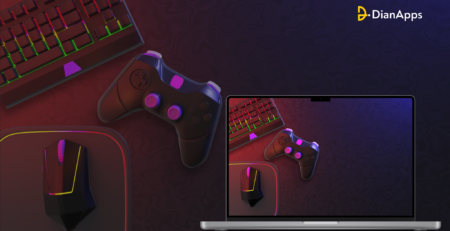Top 12 Intuitive UI/UX Design Tools for Contemporary Designers
Are you a designer on the lookout for the best UI/UX design tools to take your web app development game to the next level in 2023? Then, call off the search! As we’ve compiled a list of the top 12 intuitive design tools for contemporary designers that are sure to elevate your work and enhance your productivity.
From Sketch’s comprehensive design toolkit to Marvel’s user-friendly prototyping tools, each of these software options has something unique to offer. Plus, with FlowMapp’s collaboration and content planning tools, you’ll be able to streamline your workflow and stay on the same page with your team.
But that’s not all – we’ve also included options like Proto.io, Adobe XD, InVision Studio, and many more. Each of which boasts its own set of intuitive features and functionalities. Whether you’re an experienced web design pro or just starting out, these tools are sure to help you take your projects to new heights.
So why wait? Dive in and discover the perfect UI/UX design tool for your needs today!
Best UI/UX Design Tools to pick in 2023
Sketch
Features:
- Create prototypes
- Visual design for web-based products
- Collaboration tools
Suitability: macOS
The most well-known design tool today, Sketch debuted as a purely visual design tool for web-based products. Given its user-friendly layout, it’s understandable why the software is another go-to for UI designers just getting their feet wet in UX design. Product design is a strong rival to Figma thanks to its capacity to produce beautiful interfaces.
Since its inception, it has begun to add more capabilities, like real-time collaboration tools and a prototype tool, and it also effortlessly interacts with third-party plug-ins.
Linux and Windows users will need to seek elsewhere, despite dominating the design world on macOS, it’s only accessible on that one platform.
Marvel
Features:
- Create prototypes and wireframes
- User testing for prototypes
Suitability: Browser, Android, and iOS apps
Marvel is a flexible design tool that can be used for everything from wireframing and design to prototyping and user testing. Its exceptional usability makes it a great choice for swiftly developing prototypes and constructing effective user interfaces.
Perhaps Marvel offers tools for every stage of the creative process, prototyping is the company’s main priority. Users can easily build fully-functional prototypes by adding screen elements, importing designs, and implementing gestures. While it may not appear to be as sophisticated as other tools, it’s a top choice for inexperienced designers and developers looking for a quick and simple design tool.
FlowMap
Features:
- User research functionality
- Site-mapping tool
- User persona feature
- Plan UI & UX of apps, websites, and digital products
- Content planning tool
- Collaboration tool
Suitability: Browsers
UX/UI design tools, as well as tools for communication, teamwork, and content preparation, are all available through FlowMapp. Concentrating on UX tools, FlowMapp offers user research functionalities along with a flowchart tool that assists in planning the UI and UX of applications, digital products, and websites.
It’s quite simple to use the sitemap tool, which enables users to collaborate, create individual pages, and plan the content and specific page objectives for each of them.
Eventually, the service offered by FlowMapp expands to include additional helpful features, such as their Personas tool, which enables customers to create buyer personas. This is why, FlowMapp is a good choice for small teams working in UX/UI design agencies and aids in maintaining team communication, potentially enhancing user experience.
Adobe XD
Features:
- Create workflows, animated transitions, element creation, and dynamic elements
- Create product prototypes, websites, and mobile apps
Suitability: macOS and Windows
The UI design tools from Adobe, dubbed XD, are targeted at developing websites, mobile apps, and product prototypes. It gives designers the resources they need to produce complete prototypes, including processes, element creation, animation transitions, other dynamic features, and more.
It goes without saying that one advantage of choosing a product from an amazing suite like adobes is that they all seamlessly work together. And while expensive tools, like Photoshop in particular, are offered, larger businesses may find the Creative Cloud package appealing as a variety of applications, like Illustrator and InDesign, are made available together.
InVision
Features:
- Standalone design and UX tool
- Outline user journeys
- Create design handoff attributes
Suitability: Windows and macOS
Are you looking for a UI/UX design tool that is strong and cooperative? Here’s InVision, a versatile design tool that has a strong focus on enabling a top user experience. Using Invision, a UI/UX designer can go from outlining the user journey to collaborating on early design to wireframes and prototypes, and finally to its design handoff features. Having a single platform that takes users from early brainstorms to development is exceptionally useful.
Of all the above features, InVision’s prototyping tool leads the way. Users can create interactive prototypes, which automatically adjust according to the device and orientation, along with their colleagues. Alongside this is InVision Studio—the new standalone digital design and UX tool. InVision Studio offers an impressive suite of features, such as a vector-drawing tool, interactive designs, and built-in animations.
Miro
Features:
- Powerful sticky notes
Suitable: tablet, desktop (browser and app), and mobile
Apparently, Miro is a virtual whiteboard similar to those found in conference rooms. The left side of the screen is where you’ll find all the tools. Similar to a physical whiteboard, it enables you to add different information, such as texts and photographs, and construct maps and diagrams. Moreover, it lets users collaborate with a team using visual templates.
With a variety of tasks that need teamwork, like workshopping, strategy mapping, product development, Agile ceremonies, UX research and design, customer discovery, and process visualization, Miro as a whiteboarding platform lets your team move beyond brainstorming.
Axure RP
Features:
- Create wireframes and low-fidelity prototypes
- Add animations, dynamic panels, and graphic interactions
Suitability: Windows and macOS
Axure offers a user-friendly platform that doesn’t sacrifice functionality when developing wireframes and low-fidelity prototypes. Without writing a single line of code, users can quickly design prototypes with data-driven interactions using the program.
Dynamic panels, animations, and graphic interactions are just a few examples of the features that Axure makes adding particularly simple. Axure also permits numerous designers to work on the same project file at the same time, just like the other programs on our list. The final result is the quick creation of functional prototypes, yet its high-end pricing makes it more alluring to businesses.
Framer
Features:
- Visual design
- Basic user testing
- Create wireframes
- Develop high-fidelity prototypes & work on-screen design
- Requires a raw level of HTML and CSS coding
Suitability: Framer works on Browser (free) and macOS (Pro)
A great tool for working on-screen design and making high-fidelity prototypes is Framer, formerly known as Framer X. As it requires a fundamental understanding of CSS and HTML code for aspects like interactivity and animations, Framer is famous for having a steep learning curve. But, final prototypes made with Framer are the closest a prototype may come to a finished product.
Although the prototype is Framer’s primary role, the company has also been working on a wide range of additional tools, including wireframing and visual design. Since Framer includes certain essential capabilities for user testing, it is a useful all-in-one tool at a fair price.
Figma
Features:
- Cloud-based design
- Design and build prototypes
- Create wireframes, mind maps, mood boards
- Collaboration tools
Suitability: Browser, macOS, and Windows
One of the most widely used design tools is called Figma. It has a cloud-based design tool that is used to create prototypes with attractive design elements. Wireframes and other deliverables like mood boards can also be made with the software. The layout’s size enables numerous iterations to be applied to the same project and allows for simple design comparison.
Figma’s collaborative features, which enable numerous users to make modifications to a design at once without downloading data locally, are a major bonus. Anyone can use Figma on multiple operating systems thanks to its browser capabilities. Finally, Figma is a fantastic choice for anything design-related because it connects easily with programs like Maze, Zeplin, and Confluence.
Origami Studio
Features:
- High-fidelity prototyping tool
- Patch editor and library of existing patches
Suitability: macOS, Android, and iOS devices
Originally developed for Facebook’s designers to utilize, Origami Studio is a program that is now freely accessible to all users. Compared to other options on our list, it offers a more complicated prototyping tool, offering designers the means to produce prototypes with higher quality.
Using a large library of pre-existing patches, the tool’s patch editor is used to create the prototypes’ logic. Due to the user’s ability to visualize exactly how the website is supposed to function, this causes a concentration on specific sites. Origami is designed to aid designers in producing high-end prototypes, thus there is a small learning curve, especially for new designers.
Proto.io
Features:
- Create high-fidelity prototypes
- Collaboration tools
Suitability: Browsers
Another excellent site that enables UX/UI designers to make highly functional prototypes while yet being beginner-friendly is proto.io. It’s difficult to pull off this combo, but Proto.io accomplishes it beautifully, producing results that function and feel polished.
Due to its easy learning curve and abundance of tools to begin assembling interactions within the prototype, it is especially well-liked among students. Designers can plan, develop, and even test high-fidelity prototypes using Proto.io, which also enables team communication throughout the process.
UXPin
Features:
- Create high-fidelity prototypes
- Import designs from other tools
- Simple, drag-and-drop functionality
Suitability: macOS, Windows, and browsers
With a strong emphasis on the finish, UXPin provides tools for product designers to complete their work from beginning to end. The most intricate and “final” prototypes on this list are produced by it, leading to goods that are just a hair’s breadth from being fully functional.
Furthermore, even with interactions, animations, and other features incorporated, this outcome may be obtained without the need for designers to be proficient in programming. Even when creating high-fidelity prototypes, the tool is incredibly simple to use due to its drag-and-drop capability.
The user’s designs can be seamlessly integrated when imported from other programs. In order to give user functionality to static graphics, layers are preserved.
Also read: Future of Software Design: Excellent 2023 UX Trends to Implement in your Digital Product
Wrapping up
In a nutshell, the field of UI/UX design service is always changing, and it might be difficult to stay current with the newest styles and resources. But with these top 12 simple design tools for modern designers, you’ll have all you need to stay ahead of the curve and produce gorgeous, user-friendly experiences.
These software alternatives address all your needs, whether you’re searching for a complete design toolkit like Sketch, a solution that focuses on collaboration like FlowMapp, or an easy-to-use prototyping tool like Marvel. There is also a tool out there that will suit your particular requirements and tastes, including possibilities like Figma, Adobe XD, and InVision Studio.
As a part of the best website development company, DianApps, we understand the importance of intuitive design in creating successful digital products. Our team of expert web designers has years of experience in crafting exceptional UI/UX designs that are both visually stunning and user-friendly. Whether you’re in need of web design, mobile app design, or custom software development, we have the expertise and knowledge to bring your vision to life.
So, why would you accept anything less than the best? Contact us today to learn more about our exceptional UI/UX design services and how we can help bring your vision to life.




